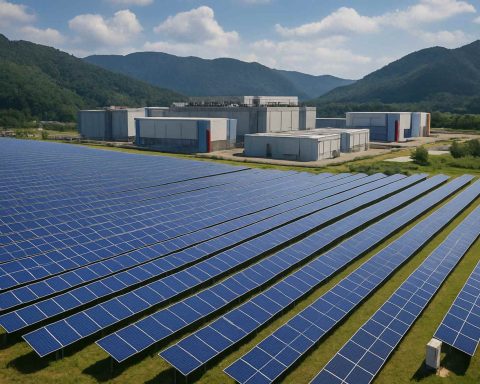- Global electric vehicle (EV) sales reached 1.5 million in April, marking a 29% annual increase, with a total of 5.6 million units sold in the first third of 2025.
- China leads the EV market, selling 3.3 million cars from January to April, driven by trade-in schemes, despite a temporary monthly sales dip.
- Western Europe’s EV market, led by Germany, Italy, and Spain, shows strong growth due to stringent emissions targets, while France experiences a decline due to reduced incentives.
- North America’s EV sales grew modestly by 5%, with 600,000 units sold, despite tariff impacts.
- Lesser-discussed global regions are seeing an impressive 37% rise in EV sales, contributing to a worldwide shift towards electrification.
- The EV market continues to expand, highlighting a shift towards cleaner transportation despite economic and geopolitical challenges.
Here come the electric vehicles, not with a roar of combustion, but the quiet hum of innovation sweeping across global markets. The world is experiencing a notable shift, as 1.5 million electric vehicles (EVs) took to the roads in April alone—an annual surge of 29%. While this represents a slight dip compared to March, one cannot ignore the trail of progress being blazed across continents.
In the first third of 2025, global EV sales have revved up to 5.6 million units, marking the same percentage growth year-on-year. China remains at the helm, steering the largest fleet with 3.3 million cars sold from January to April, reflecting a robust 35% increase from last year. This is largely driven by trade-in schemes that encourage drivers to switch to electric, despite a slight lull in the monthly momentum.
As we drift westward to Europe, there’s a tale of two markets. Western Europe stands as a beacon of acceleration, ignited by stringent emissions targets. Germany, Italy, and Spain accelerated their sales with impressive sprinters’ strides, each showcasing growth over 40%. Meanwhile, France pumps the brakes, seeing a contraction of 14%, where dampened consumer incentives act as a restraining force.
Across the pond, North America tells a different story. The market has expanded by a modest 5%, translating to 600,000 EVs finding homes from Canada to Mexico within the first four months. Here, tariffs, particularly those enacted by the Trump administration, cast a looming shadow but not a tether, as domestic production absorbs much of the impact.
Globally, lesser-discussed regions collectively embody the undercurrent of growth, together recording a 37% uptick in sales. These statistics underscore a universal appetite for electrification despite the complexities of geopolitical tariff wars and wavering economic forecasts.
The true narrative here is not one of decline, despite the monthly variance, but of momentum and resilience. EVs are not merely the vehicles of the future; they’re becoming the present. As nations jockey for position in this vehicular revolution, they emit one clear message: the transition to cleaner, electric transport is not a mere trend—it’s a pivotal chapter in our technological and environmental evolution.
Why Electric Vehicles Are Driving the Future: Key Insights and Practical Tips
The Global Surge of Electric Vehicles
The electric vehicle (EV) market is experiencing unprecedented growth, with 1.5 million EVs hitting the roads globally in April alone, reflecting a 29% annual surge. Despite a slight month-to-month dip, the trend is clear: EVs are becoming an integral part of modern transportation. By the first third of 2025, global EV sales reached 5.6 million units, maintaining this dynamic growth rate year-on-year.
Regional Highlights: Understanding the Global EV Market
China: Leading the Charge
China remains the frontrunner, selling 3.3 million EVs from January to April, a 35% increase from the previous year. This is largely due to government initiatives like trade-in schemes that encourage consumers to transition from traditional combustion engines to electric alternatives. These policies are pivotal in maintaining momentum, despite a slight decrease in monthly sales.
Europe: A Tale of Two Strategies
Europe presents a dual narrative:
– Western Europe: Countries like Germany, Italy, and Spain are achieving impressive sales growth over 40%, driven by stringent emissions targets and robust governmental incentives.
– France: On the other hand, faces a 14% sales contraction due to reduced consumer incentives, underscoring the critical role of policy in the EV adoption rate.
North America: Navigating Tariffs
With a modest 5% market expansion—600,000 EVs sold in the first four months—North American EV growth remains steady. While tariffs, particularly those from the Trump era, pose challenges, local manufacturing has mitigated some impacts, indicating a resilient but cautious market approach.
Emerging Markets: Untapped Potential
Lesser-discussed regions collectively posted a 37% increase in sales, demonstrating a growing interest in electrification. This growth illustrates a universal shift towards cleaner transportation options, despite ongoing tariff disputes and economic uncertainties.
Market Forecasts & Industry Trends
The EV market is projected to continue its robust expansion, with BloombergNEF predicting that EVs will comprise 58% of global passenger vehicle sales by 2040. Key factors influencing this growth include:
– Battery Technology Advancements: The development of more efficient, longer-lasting batteries is critical. Companies are investing heavily in research and development to improve battery life and reduce costs.
– Infrastructure Development: A significant push towards expanding charging infrastructure is necessary to accommodate growing EV numbers. Countries are investing in fast-charging stations and encouraging private sector participation.
– Environmental Concerns: Increasing awareness and concern over climate change are accelerating the demand for sustainable transport solutions.
Pros & Cons Overview
Pros:
– Environmental Impact: Reduced greenhouse gas emissions contribute positively to global environmental goals.
– Cost Efficiency: Lower operating costs due to savings on fuel and maintenance.
– Technological Innovation: Continued advancements lead to enhanced performance and features.
Cons:
– Initial Cost: Higher upfront costs compared to traditional vehicles.
– Charging Infrastructure: Limited availability in certain regions can impede adoption.
– Range Anxiety: Concerns about battery range still persist among consumers.
Actionable Recommendations
1. Consider Government Incentives: Research available incentives in your region to offset initial EV costs.
2. Evaluate Long-Term Savings: Factor in lower maintenance and fuel costs when assessing the total cost of ownership.
3. Plan for Charging: Prioritize EV models with suitable battery range for your lifestyle and confirm charging infrastructure availability in frequent areas.
4. Stay Informed: Keep up to date with industry trends to leverage upcoming EV technologies and capabilities.
For more information on electric vehicles and their impact, visit Bloomberg.
Electric vehicles are not just the future—they are the present, reshaping the automotive landscape and paving the way for a sustainable tomorrow. Adopting an EV could not only save money but also contribute effectively to mitigating climate change.













